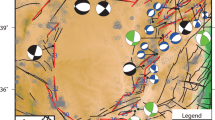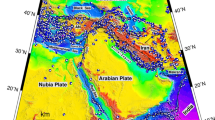Abstract
The Vienna Basin Transfer Fault (VBTF) is a slow active fault with moderate seismicity (I max~8–9, M max~5.7) passing through the most vulnerable regions of Austria and Slovakia. We use different data to constrain the seismic potential of the VBTF including slip values computed from the seismic energy release during the 20th century, geological data on fault segmentation and a depth-extrapolated 3-D model of a generalized fault surface, which is used to define potential rupture zones. The seismic slip of the VBTF as a whole is in the range of 0.22–0.31 mm/year for a seismogenic fault thickness of 8 km. Seismic slip rates for individual segments vary from 0.00 to 0.77 mm/year. Comparing these data to geologically and GPS-derived slip velocities (>1 mm/year) proofs that the fault yields a significant seismic slip deficit. Segments of the fault with high seismic slip contrast from segments with no slip representing locked segments. Fault surfaces of segments within the seismogenic zone (4–14 km depth) vary from 55 to 400 km2. Empirical scaling relations show that these segments are sufficiently large to explain both, earthquakes observed in the last centuries, and the 4th century Carnuntum earthquake, for which archeo-seismological data suggest a magnitude of M ≥ 6. Based on the combination of all data (incomplete earthquake catalog, seismic slip deficits, locked segments, potential rupture areas, indications of strong pre-catalog earthquakes) we argue, that the maximum credible earthquake for the VBTF is in the range M max = 6.0–6.8, significantly larger than the magnitude of the strongest recorded events (M = 5.7).







Similar content being viewed by others

References
ACORN (2004) Catalogue of Earthquakes in the Region of the Alps—Western Carpathians—Bohemian Massif for the period from 1267 to 2004, Computer File. Vienna (Central Institute for Meteorology and Geodynamics, Department of Geophysics)—Brno (Institute of Physics of the Earth, University Brno)
Amelung F, King G (1997) Earthquake scaling laws for creeping and non-creeping faults. Geophys Res Lett 24(5):507–510
Aric K, Gutdeutsch R (1981) Seismotectonic and refraction seismic investigation in the border region between the Eastern Alps and the Pannonian Basin. Pure Appl Geophys 119:1125–1133
Beidinger A (2009) Geophysical, geomorphological and geological investigations along the Lassee-Segment of the Vienna Basin Transfer Fault System (VBTF). Diploma Thesis, University of Vienna, 82 p
Beidinger A, Decker K, Roch KH (2010) The Lassee segment of the Vienna Basin Fault System as a potential source of the earthquake of Carnuntum in the fourth century A.D. Int J Earth Sci (in press). doi: 10.1007/s00531-010-0546-x
Brune JN (1968) Seismic moment, seismicity, and rate of slip along major fault zones. J Geophys Res 73(2):777–784
Bus Z, Grenerczy G, Tóth L, Mónus P (2009) Active crustal deformation in two sesimogenic zones of the Pannonian region–GPS versus seismological observations. Tectonophysics 474:343–352
Camelbeeck T, Maghraoui M (1996) Large earthquakes in northern Europe more likely than once thought. EOS 77(42):405–409
CDMG/USGS (1996) California department of conservation division of mines and geology and US. Geological survey, Probabilistic seismic hazard assessment for the state of California. California Department of Conservation Division of Mines and Geology open file report, 96-08
Cloetingh S, Ziegler P, Cornu T, Ustaszewski K, Schmid S, Dezes P, Hinsch R, Decker K, Cardozo GL, Granet M, Bertrand G, Behrmann J, Michon L, Pagnier H, Wees JDv, Rozsa S, Heck B, Mayer M, Verdun J, Kahle HG, Fracassi U, Winter T, Burov E (2003) Investigating environmental tectonics in the Northern Alpine Foreland of Europe. EOS 84(36):349 (356–357)
Decker K, Burmester G (2008) Stress orientations and active fault kinematics of the Vienna Basin Fault System, Austria. In: 3rd World stress map conference, frontiers of stress research, Helmholtz Centre Potsdam. GFZ German Research Centre for Geosciences (Abstracts, p 110)
Decker K, Peresson H (1998) Miocene to present-day tectonics of the Vienna Basin transform fault. In: Links between the Alps and the Carparthians, XVI congress of the Carparthian-Balkan geological association. Geologische Bundesanstalt, Vienna, pp 33–36
Decker K, Peresson H, Hinsch R (2005) Active tectonics and Quaternary basin formation along the Vienna Basin transform fault. Quat Sci Rev 24:305–320
Decker K, Gangl G, Kandler M (2006) The earthquake of Carnuntum in the fourth century AD–archaeological results, seismologic scenario and seismotectonic implications for the Vienna Basin fault, Austria. J Seismol 10(4):479–495
Fuchs W, Grill R (1984) Geologische Karte von Wien und Umgebung. Geologische Bundesanstalt (GBA), Vienna
Gangl G (1975) Seismotektonische Untersuchungen am Alpenostrand. Mitteilungen der Geologischen Gesellschaft in Wien 66–67(1973–1974):33–48
Gangl G, Decker K, Kandler M (2001) Seismological interpretation of the Roman excavation of damaged masonry structures in Carnuntum. Workshop of the ESC working group “Historical Seismology”. Vienna, Central Institute for Meteorology and Geodynamics (ZAMG), Austria
Grenerczy G, Kenyeres A, Fejes I (2000) Present crustal movement and strain distribution in Central Europe inferred from GPS measurements. J Geophys Res 105(B9):21835–21846
Grenerczy G, Sella G, Stein S, Kenyeres A (2005) Tectonic implications of the GPS velocity field in the northern Adriatic region. Geophys Res Lett 32:L16311. doi:10.1029/2005GL022947
Grünthal G, Mayer-Rosa D, Lenhardt WA (1998) Abschätzung der Erdbebengefährdung für die D-A-CH-Staaten—Deutschland, Österreich, Schweiz. Bautechnik 10:19–33
Gutdeutsch R, Aric K (1988) Seismicity and neotectonics of the East Alpine-Carpathian and Pannonian Area. In: Royden LH, Horvath F (eds) The Pannonian basin: a study in basin evolution. AAPG Memoir 45. American Association of Petroleum Geologists and Hungarian Geological Society, Tulsa, pp 183–194
Gutdeutsch R, Hammerl C, Mayer I, Vocelka K (1987) Erdbeben als historisches Ereignis. Die Rekonstruktion des Bebens 1590 in Niederösterreich. Springer, Berlin
Hanks TC, Kanamori H (1979) A moment magnitude scale. J Geophys Res 84(B5):2348–2350
Hinsch R, Decker K (2003) Do seismic slip deficits indicate an underestimated earthquake potential along the Vienna Basin Transform Fault system? Terra Nova 15:343–349
Hinsch R, Decker K, Wagreich M (2005a) 3-D mapping of segmented active faults in the southern Vienna Basin. Quat Sci Rev 24:321–336
Hinsch R, Decker K, Peresson H (2005b) 3-D seismic interpretation and structural modeling in the Vienna Basin: implications for Miocene to recent kinematics. Austrian J Earth Sci 97:38–50
Hintersberger E, Decker K, Lomax J (2010) Largest Earthquake North of the Alps excavated within the Vienna Basin, Austria. European Seismological Commission (ESC) 32nd General Assembly, Montpellier, France. Abstract T/Sd2/TU/05
Holt WE, Chamot-Rooke N, Le Pichon X, Haines AJ, Sheng-Tu B, Ren J (2000) Velocity field in Asia inferred from Quaternary fault slip rates and global positioning system observations. J Geophys Res 105(B8):19185–19209
Hölzel M, Decker K, Zámolyi A, Strauss P, Wagreich M (2010) Lower Miocene structural evolution of the central Vienna Basin (Austria). Marine Petrol Geol 27:666–681
Hoprich M, Decker K, Grasemann B, Sokoutis D, Willingshofer E (2008) Auswirkung eines geneigten Abscherhorizontes auf die Entwicklung von Pull-Apart Becken: Analogmodellierung und Vergleich mit dem Wiener Becken, Abstract, PANGEO 2008. J Alp Geol 49:46
Kandler M (1989) Eine Erdbebenkatastrophe in Carnuntum? Acta Archaeologia Academia Scientiarum Hungarica 41:313–336
Kröll A, Wessely G (1993) Wiener Becken und angrenzende Gebiete: Strukturkarte—Basis der tertiären Beckenfüllung. Geologische Bundesanstalt, Vienna
Kröll A, Wessely G, Zych D (2001) Molassezone Niederösterreich und angrenzende Gebiete—Strukturkarte der Molassebasis. Geologische Bundesanstalt, Vienna
Lenhardt WA (1995) Regional earthquake hazard in Austria. In: Duma G (ed) 10th European conference on earthquake engineering. Vienna, Austria. Balkema, Rotterdam, pp 63–68
Lenhardt WA (1996) Erdbebenkennwerte zur Berechnung der Talsperren Österreichs, Zentralanstalt für Meteorologie und Geodynamik (ZAMG), Wien (85 pp)
Linzer H-G, Moser F, Nemes F, Ratschbacher L, Sperner B (1997) Build-up and dismembering of the eastern Northern Calcereous Alps. Tectonophysics 27:97–124
Linzer H-G, Decker K, Peresson H, Dell’Mour R, Frisch W (2002) Balancing lateral orogenic float of the Eastern Alps. Tectonophysics 354(3–4):211–237
Mallet JL (1992) Discrete smooth interpolation in geometric modeling. Comput Aided Des 24(4):178–191
Marko F, Fodor L, Kovác M (1991) Miocene strike slip faulting and block rotation in Brezovské Karpaty Mts. (Western Carpathians). Mineralia slovaca 23:189–200
Meghraoui M, Delouis B, Ferry M, Giardini D, Huggenberger P, Spottke I, Granet M (2001) Active normal faulting in the Upper Rhine Graben and Paleoseismic identification of the 1356 Basel earthquake. Science 293:2070–2073
Purcaru G, Berckhemer H (1978) A magnitude scale for very large earthquakes. Tectonophysics 49:189–198
Ratschbacher L, Frisch W, Linzer H-G, Merle O (1991) Lateral extrusion in the Eastern Alps. Tectonics 10:257–271
Reinecker J, Lenhardt W (1999) Present-day stress field and deformation in eastern Austria. Int J Earth Sci 88:532–550
Royden LH (1988) Late Cenozoic tectonics of the Pannonian basin system. In: Royden LH, Horvath F (eds) The Pannonian basin: a study in basin evolution. AAPG Memoir 45. American Association of Petroleum Geologists and Hungarian Geological Society, Tulsa, pp 27–48
Royden LH, Horvath F, Rumpler J (1983) Evolution of the Pannonian basin system, 1. Tectonics. Tectonics 2:63–90
Salcher BC, Wagreich M (2009) Climate and tectonic controls on Pleistocene sequence development and river evolution in the Southern Vienna Basin (Austria). Quat Int. doi: 10.1016/j.quaint.2009.04.007
Salcher B, Decker K, Meurers B, Hölzel M, Wagreich M (2009) Pleistocene structures and geomorphology in the southern and central Vienna Basin, vol 11. EGU General Assembly 2009, Geophysical Research Abstracts, EGU2009-6217
Salcher BC, Faber R, Wagreich M (2010) Climate as main factor controlling the sequence development of two Pleistocene alluvial fans in the Vienna Basin (eastern Austria)—A numerical modelling approach. Geomorphology 115:3–4 (215–227)
Santanach P, Masana E (2001) Prospects for Paleoseismology in Spain. Acta Geol Hispanica 36(3–4):193–196
Scholz CH (2002) The mechanics of earthquakes and faulting, 2nd edn. Cambridge Univ. Press, Cambridge (471 pp)
Schwarz PD, Coppersmith KJ (1984) Fault behaviour and characteristic earthquakes: examples from the Wasatch and San Andreas Fault zones. J Geophys Res 89:5681–5698
Slejko D, Peruzza L, Rebez A (1998) Seismic hazard of Italy. Ann Geophys 41:183–214
SRTM 2004, Void-filled seamless SRTM data V1 (2004) International centre for tropical agriculture (CIAT). Available from the CGIAR-CSI SRTM 90 m Database: http://srtm.csi.cgiar.org and http://www.ambiotek.com/topoview
Tóth L, Győri E, Mónus P, Zsíros T (2006) Seismic Hazard in the Pannonian region. In: Pinter N, Grenerczy G, Weber J, Stein S, Medak D (eds) The Adria Microplate: GPS Geodesy, Tectonics and Hazards. NATO ARW series, vol 61. Springer, Berlin, pp 369–384
Vanneste K, Maghraoui M, Camelbeeck T (1999) Late Quaternary earthquake-related soft-sediment deformation along the Belgian portion of the Feldbiss Fault, Lower Rhine Graben system. Tectonophysics 309:57–79
Wells DL, Coppersmith KJ (1994) New empirical relationships among magnitude, rupture width, rupture area, and surface displacement. Bull Seismol Soc Am 84(4):974–1002
Wessely G (1993) Der Untergrund des Wiener Beckens. In: Brix F, Schulz O (eds) Erdöl und Erdgas in Österreich. Naturhistorisches Museum Wien und F. Berger, Horn, pp 249–280
WGCEP (Working Group on California Earthquake Probabilities) (1988) Probabilities of large earthquakes occurring in California on the San Andreas fault. USGS Open-File Report, 88-398
WGCEP (Working Group on California Earthquake Probabilities) (1995) Seismic hazards in southern California: probable earthquakes, 1994 to 2024. Bull Seismol Soc Am 85:379–439
WGCEP (Working Group on California Earthquake Probabilities) (2003) Earthquake probabilities in the San Francisco Bay region: 2002–2031. USGS Open-File Report, 03-214
ZAMG (2008) Earthquake catalogue of felt earthquakes 1201–2008 A.D. (Austria). Computer file. Central Institute of Meteorology and Geodynamics (ZAMG), Vienna
Acknowledgments
We had inspiring discussions on seismology with G. Gangl and W. Lenhardt, who also made the earthquake catalogs available for research. C. Hulka is thanked for prove reading of the manuscript. Constructive reviews were provided by S. Cloetingh and B. Salcher, improving the quality of the paper.
Author information
Authors and Affiliations
Corresponding author
Rights and permissions
About this article
Cite this article
Hinsch, R., Decker, K. Seismic slip rates, potential subsurface rupture areas and seismic potential of the Vienna Basin Transfer Fault. Int J Earth Sci (Geol Rundsch) 100, 1925–1935 (2011). https://doi.org/10.1007/s00531-010-0613-3
Received:
Accepted:
Published:
Issue Date:
DOI: https://doi.org/10.1007/s00531-010-0613-3



